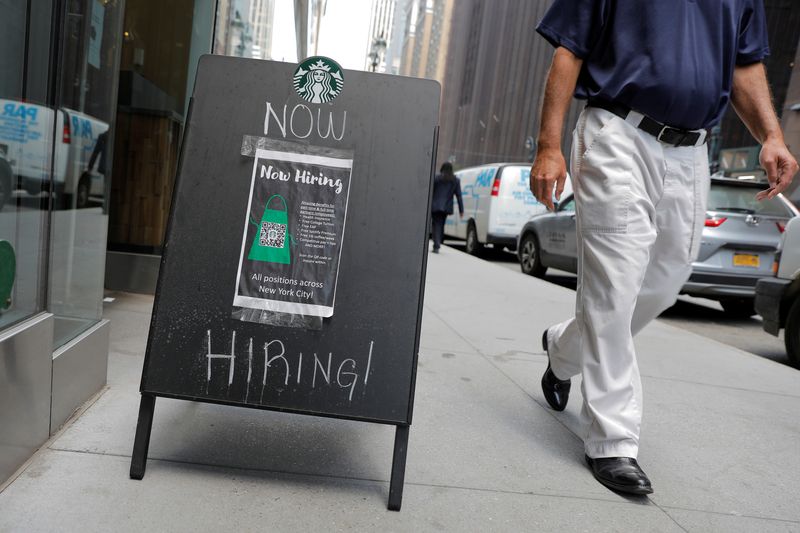Investing.com -- Friday’s nonfarm payrolls report and Wednesday’s minutes of the Federal Reserve’s June meeting will be the highlights of a holiday-shortened week. The stock markets go into the second half with a tailwind after strong gains in the first six months of the year. The Reserve Bank of Australia is set to make its latest rate decision while PMI data from China is likely to underscore the need for more stimulus measures
1. Nonfarm payrolls
Friday’s U.S. employment report will be the main event, with economists expecting the economy to have added 200,000 jobs in June.
In May, the economy added a far larger than forecast 339,000 jobs, although an uptick in the unemployment rate to a seven-month high of 3.7% indicated that labor market conditions were easing.
Signs of continued strength in the labor market could underline a view that has helped boost markets this year: that the U.S. economy can avoid a severe recession despite the Fed’s aggressive tightening.
"The labor market is probably going to end up proving to be the big catalyst for what may happen market-wise and also monetary policy-wise," Omar Aguilar, chief executive officer and chief investment officer of Schwab Asset Management told Reuters.
Ahead of Friday’s jobs report, markets will get updates on other areas of the labor market with data on private sector hiring from ADP, JOLTS job openings and weekly unemployment claims.
2. Fed minutes
The Fed on Wednesday is to publish the minutes of its June 13-14 meeting when it held rates steady after 10 straight rate hikes, but indicated that two more increases are coming this year, including one widely expected in July.
On Friday a gauge of inflation that is closely followed by the U.S. central bank indicated that price pressures are cooling, fueling hopes the Fed could be near the end of its rate-hiking cycle.
The minutes should give investors more insight into the debate over what Fed Chair Jerome Powell has said is an increasingly even balance of risks between doing too little and going too far on policy tightening.
In comments last Thursday Powell reiterated that "a strong majority" of Fed policymakers expect they will need to raise interest rates at least twice more by year's end.
3. Second half gets underway
The U.S. stock market has rallied in the first half of 2023, powering higher despite a crisis in the banking sector and fears over the prospect of a recession.
The S&P 500 has risen 15.9% since the start of the year and the tech-heavy Nasdaq Composite has gained 31.7%, for its biggest first-half increase in 40 years.
"We have had a pretty resilient market in the first half of this year,” Mona Mahajan, senior investment strategist at Edward Jones told Reuters. “The market needs one big question answered, and that is what does the economy look like in the back half of the year.”
Investors are hoping that the strong gains in the first half of the year will give a tailwind to markets going into the second half of the year, but this month will bring several market-moving events - Friday’s jobs report, followed by the start of second-quarter earnings season along with a key inflation report next week ahead of the Fed’s next policy decision on July 26.
4. RBA decision
The Reserve Bank of Australia holds its July policy meeting on Tuesday and markets are unsure of whether it might further raise the 4.1% cash rate or pause to see how past tightening is working.
The RBA has hiked interest rates by a huge 400 basis points in the past year in an attempt to cool demand and curb sky-high inflation.
Resilient retail sales data last Thursday suggested some cushion for another rate rise, a day after data showing that inflation slowed sharply in May to its lowest in 13 years saw an aggressive paring of tightening bets.
Prior to that, a blockbuster jobs report mid-month had seen hike bets rise, after getting wound down following surprisingly dovish minutes of the June meeting, showing the decision to raise rates was "finely balanced".
5. China factory PMI
China is to release the Caixin purchasing managers index on Monday which will give an update on the strength of the manufacturing sector as the post-COVID economic recovery in the world’s second-largest economy falters.
The data is likely to underscore the need for more stimulus measures amid weak demand both at home and abroad and prop up a weakening currency.
The yuan has lost nearly 5% to the dollar this year, becoming one of the worst-performing Asian currencies.
Widening bond yield differentials between the U.S. and China, fueled by growing monetary policy divergence have pressured the yuan.
--Reuters contributed to this report
